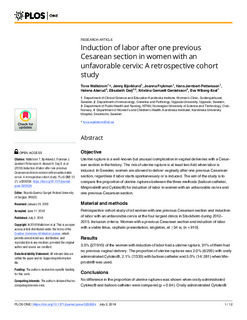| dc.contributor.author | Wallstrom, Tove | |
| dc.contributor.author | Björklund, Jenny | |
| dc.contributor.author | Frykman, Joanna | |
| dc.contributor.author | Järnbert-Pettersson, Hans | |
| dc.contributor.author | Akerud, Helena | |
| dc.contributor.author | Darj, Elisabeth | |
| dc.contributor.author | Gemzell-Danielsson, Kristina | |
| dc.contributor.author | Wiberg-Itzel, Eva | |
| dc.date.accessioned | 2019-09-19T07:37:29Z | |
| dc.date.available | 2019-09-19T07:37:29Z | |
| dc.date.created | 2019-01-25T14:37:00Z | |
| dc.date.issued | 2018 | |
| dc.identifier.citation | PLOS ONE. 2018, 13 (7), . | nb_NO |
| dc.identifier.issn | 1932-6203 | |
| dc.identifier.uri | http://hdl.handle.net/11250/2617538 | |
| dc.description.abstract | Objective
Uterine rupture is a well-known but unusual complication in vaginal deliveries with a Cesarean section in the history. The risk of uterine rupture is at least two-fold when labor is induced. In Sweden, women are allowed to deliver vaginally after one previous Cesarean section, regardless if labor starts spontaneously or is induced. The aim of the study is to compare the proportion of uterine ruptures between the three methods (balloon catheter, Minprostin® and Cytotec®) for induction of labor in women with an unfavorable cervix and one previous Cesarean section.
Material and methods
Retrospective cohort study of all women with one previous Cesarean section and induction of labor with an unfavorable cervix at the four largest clinics in Stockholm during 2012–2015. Inclusion criteria: Women with a previous Cesarean section and induction of labor with a viable fetus, cephalic presentation, singleton, at ≥34 w, (n = 910).
Results
3.0% (27/910) of the women with induction of labor had a uterine rupture, 91% of them had no previous vaginal delivery. The proportion of uterine ruptures was 2.0% (6/295) with orally administrated Cytotec®, 2.1% (7/335) with balloon catheter and 5.0% (14/ 281) when Minprostin® was used.
Conclusions
No difference in the proportion of uterine ruptures was shown when orally administrated Cytotec® and balloon catheter were compared (p = 0.64). Orally administrated Cytotec® and balloon catheter give a high success rate of vaginal deliveries (almost 70%) despite an unfavorable cervix. | nb_NO |
| dc.language.iso | eng | nb_NO |
| dc.publisher | Public Library of Science (PLOS) | nb_NO |
| dc.rights | Navngivelse 4.0 Internasjonal | * |
| dc.rights.uri | http://creativecommons.org/licenses/by/4.0/deed.no | * |
| dc.title | Induction of labor after one previous Cesarean section in women with an unfavorable cervix: A retrospective cohort study | nb_NO |
| dc.type | Journal article | nb_NO |
| dc.type | Peer reviewed | nb_NO |
| dc.description.version | publishedVersion | nb_NO |
| dc.source.pagenumber | 12 | nb_NO |
| dc.source.volume | 13 | nb_NO |
| dc.source.journal | PLOS ONE | nb_NO |
| dc.source.issue | 7 | nb_NO |
| dc.identifier.doi | 10.1371/journal.pone.0200024 | |
| dc.identifier.cristin | 1665208 | |
| dc.description.localcode | Copyright: © 2018 Wallstrom et al. This is an open access article distributed under the terms of the Creative Commons Attribution License, which permits unrestricted use, distribution, and reproduction in any medium, provided the original author and source are credited. | nb_NO |
| cristin.unitcode | 194,65,20,0 | |
| cristin.unitname | Institutt for samfunnsmedisin og sykepleie | |
| cristin.ispublished | true | |
| cristin.fulltext | original | |
| cristin.qualitycode | 1 | |

